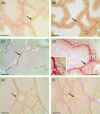Chronic caffeine intake increases androgenic stimuli, epithelial cell proliferation and hyperplasia in rat ventral prostate
- PMID: 23136995
- PMCID: PMC3521899
- DOI: 10.1111/j.1365-2613.2012.00843.x
Chronic caffeine intake increases androgenic stimuli, epithelial cell proliferation and hyperplasia in rat ventral prostate
Abstract
Coffee intake has been associated with a low risk of developing cancer, including prostate cancer, which is one of the most commonly diagnosed cancer in men. However, few studies have evaluated the chronic effects of caffeine, which is the most abundant methylxanthine in coffee, on prostate morphology and physiology. In the present study, we investigated the effects of chronic, low-dose caffeine intake on rat prostate morphology from puberty to adulthood. Five-week-old male Wistar rats were randomized into two experimental groups: caffeine-treated (20 ppm in drinking water, n = 12) and control (n = 12). The ventral and dorsolateral prostates were dissected, weighted and submitted to morphological, morphometrical and immunohistochemical analysis of cellular proliferation, apoptosis and androgen receptor (AR) tissue expression. The testosterone (T) and dihydrotestosterone (DHT) concentrations were measured in the plasma. Our results show that caffeine intake increased the concentrations of T and DHT, organ weight, epithelial cell proliferation and AR tissue expression in the ventral prostatic lobe. All the ventral prostates from the caffeine-treated animals presented various degrees of epithelial and stromal hyperplasia. Our results suggest that chronic caffeine intake from puberty increases androgenic signalling and cell proliferation in the rat prostate gland and can be related to the development of benign prostatic hyperplasia.
© 2012 The Authors. International Journal of Experimental Pathology © 2012 International Journal of Experimental Pathology.
Figures







Similar articles
-
Quisqualis indica Improves Benign Prostatic Hyperplasia by Regulating Prostate Cell Proliferation and Apoptosis.Biol Pharm Bull. 2017 Dec 1;40(12):2125-2133. doi: 10.1248/bpb.b17-00468. Epub 2017 Sep 22. Biol Pharm Bull. 2017. PMID: 28943529
-
Psoralea corylifolia L. extract ameliorates benign prostatic hyperplasia by regulating prostate cell proliferation and apoptosis.J Ethnopharmacol. 2021 Jun 12;273:113844. doi: 10.1016/j.jep.2021.113844. Epub 2021 Jan 21. J Ethnopharmacol. 2021. PMID: 33485982
-
Kaempferol inhibits benign prostatic hyperplasia by resisting the action of androgen.Eur J Pharmacol. 2021 Sep 15;907:174251. doi: 10.1016/j.ejphar.2021.174251. Epub 2021 Jun 12. Eur J Pharmacol. 2021. PMID: 34129879
-
Increased androgen receptor expression correlates with development of age-dependent, lobe-specific spontaneous hyperplasia of the brown Norway rat prostate.Endocrinology. 2001 Sep;142(9):4066-75. doi: 10.1210/endo.142.9.8376. Endocrinology. 2001. PMID: 11517186
-
Androgen receptor signalling in prostate: effects of stromal factors on normal and cancer stem cells.Mol Cell Endocrinol. 2008 Jun 25;288(1-2):30-7. doi: 10.1016/j.mce.2008.02.024. Epub 2008 Mar 2. Mol Cell Endocrinol. 2008. PMID: 18403105 Review.
Cited by
-
High Doses of Caffeine during the Peripubertal Period in the Rat Impair the Growth and Function of the Testis.Int J Endocrinol. 2015;2015:368475. doi: 10.1155/2015/368475. Epub 2015 Apr 23. Int J Endocrinol. 2015. PMID: 25983753 Free PMC article.
-
The perinatal effects of maternal caffeine intake on fetal and neonatal brain levels of testosterone, estradiol, and dihydrotestosterone in rats.Naunyn Schmiedebergs Arch Pharmacol. 2017 Aug;390(8):827-838. doi: 10.1007/s00210-017-1383-2. Epub 2017 May 29. Naunyn Schmiedebergs Arch Pharmacol. 2017. PMID: 28555252
-
Exploring the association between caffeine intake and benign prostatic hyperplasia: results from the NHANES 2005-2008.Front Nutr. 2025 Jan 13;11:1511607. doi: 10.3389/fnut.2024.1511607. eCollection 2024. Front Nutr. 2025. PMID: 39872138 Free PMC article.
-
The effects of caffeine on wound healing.Int Wound J. 2016 Oct;13(5):605-13. doi: 10.1111/iwj.12327. Epub 2014 Jul 8. Int Wound J. 2016. PMID: 25041108 Free PMC article.
-
Flaxseed reduces epithelial proliferation but does not affect basal cells in induced benign prostatic hyperplasia in rats.Eur J Nutr. 2017 Apr;56(3):1201-1210. doi: 10.1007/s00394-016-1169-1. Epub 2016 Feb 8. Eur J Nutr. 2017. PMID: 26857761
References
-
- Bartsch G, Rittmaster RS, Klocker H. Dihydrotestosterone and the concept of 5alpha-reductase inhibition in human benign prostatic hyperplasia. World J. Urol. 2002;19:413–425. - PubMed
-
- Bettuzzi S, Brausi M, Rizzi F, Castagnetti G, Peracchia G, Corti A. Chemoprevention oh human prostate cancer by oral administration of green tea catechins in volunteers with high-grade prostate intraepithelial neoplasia: a preliminary report from a one-year proof-of-principle study. Cancer Res. 2006;66:1234–1240. - PubMed
-
- Bradford MM. A rapid and sensitive method for the quantitation of microgram quantities of protein utilizing the principle of protein-dye binding. Anal. Biochem. 1976;72:248–254. - PubMed
-
- Butt MS, Sultan MT. Coffee and its consumption: benefits and risks. Crit. Rev. Food Sci. Nutr. 2011;51:363–373. - PubMed
Publication types
MeSH terms
Substances
LinkOut - more resources
Full Text Sources
Medical
Research Materials

